Hainan declared as "World Longevity Island"
 |
|
Luoyi village in Chengmai county of Hainan is renowned as a "longevity village",more than 100 among the villagers are elderly above 80 years old, with the oldest 106 years old.[Photo provided to chinadaily.com.cn] |
Last year, media in China reported a huge number of tourists traveling to the famous Bama County, South China's Guangxi Zhuang autonomous region to seek the recipe for a long life. The county's "longevity pilgrims" can be seen crawling around on four-legs and are even known to drink urine, believing the practices help keep illness at bay.
The reputation of the remote county is so widespread that it has even attracted a number of people who travel from far away to live in Bama.
 |
This group is nicknamed "houniaoren," or "migratory people," with lives like those of migratory birds -- flying south in winter and staying in Bama for several months.
Government statistics show that in 2012 alone about 180,000 migratory people visited Bama.
Hainan had been seeing a similar occurrence, but now, with official recognition under its belt, the fervor is likely to increase.
By way of capitalizing, Hainan has stepped up efforts in building itself as an international tourism island, an ambitious scheme in line with a 2010 national strategy.
For example, the Hainan Boao Lecheng International Medical Tourism Pilot Zone, the only national pilot program in medical tourism granted by the State Council, is now under construction, featuring healthcare and longevity-related services.
The Chinese health sector is expected to grow into an 800-million-yuan (129 million U.S. dollars) industry by 2020 and will be a powerful driver for domestic consumption and employment, as it covers a wide range of services and a long industrial chain, said Li Bin, head of the National Population and Family Planning Commission.















